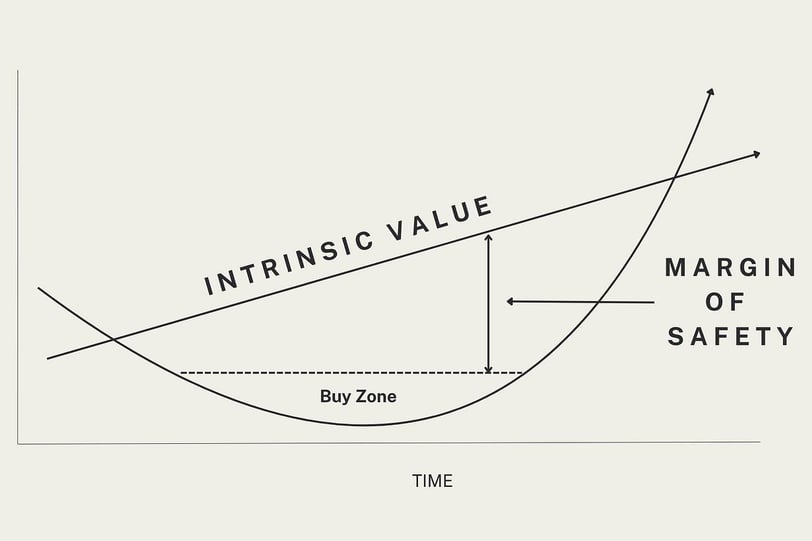Unlocking Wealth: A Beginner’s Guide to Value Investing—Learn from the Masters
Discover the power of value investing, the proven strategy used by legends like Warren Buffett, Charlie Munger, and Benjamin Graham. In this guide, you’ll learn the fundamentals of value investing, understand the crucial “Margin of Safety,” and explore practical ways to apply these strategies—be it through ETFs, stock picking, or managed funds. Plus, uncover a curated list of the best books to master value investing. Elevate your investment game today!
FUNDAMENTALS OF INVESTINGVALUE INVESTING
5/30/20255 min read


What Is Value Investing?
Value investing is a time-tested investment strategy focused on buying stocks or assets that appear underpriced by some form of fundamental analysis. The goal is to find strong, stable companies whose shares are temporarily trading below their intrinsic value. Over time, as the market recognizes their true worth, their prices tend to rise—rewarding patient investors.
This methodology has been championed by some of history's greatest investors:
Benjamin Graham, known as the “father of value investing,” introduced the concept in his classic book The Intelligent Investor.
Warren Buffett, once Graham’s student and now a modern legend, called value investing “simple, but not easy.”
Charlie Munger, Buffett’s long-time partner, stresses the importance of staying rational and disciplined.
Peter Lynch, famed for managing the Magellan Fund at Fidelity, believed in buying what you understand at undervalued prices.
These investors have not only amassed incredible wealth using this method but have also proven its efficiency in both bull and bear markets. (source)
The Core Principles of Value Investing
Intrinsic Value
Intrinsic value is the real, underlying worth of a business, not just its current stock price. Value investors spend time analyzing financial statements, earnings, and industry trends to estimate this figure, using tools like discounted cash flow models.
Buying with a Margin of Safety
The margin of safety is the buffer between a stock’s market price and its intrinsic value. It protects you from errors in analysis and unforeseen events—a concept first highlighted by Benjamin Graham. (More on this below!)
Long-term Perspective
Value investing is not about quick gains. It requires patience—often holding stocks for years until the market closes the gap between price and value.
Independent Thinking
Value investors go against the herd. They look for opportunities when others are fearful, and avoid the hype when markets are euphoric.
Efficiency and Track Record
Why does value investing work so well?
Market Overreactions: The market often misprices stocks in the short term due to emotions and news cycles. Value investing exploits these inefficiencies.
Compounding Returns: As undervalued stocks rise to their intrinsic value, investors receive outsized returns.
Risk Reduction: The margin of safety acts as a built-in protection, lowering the risk of permanent capital loss.
According to studies by Morningstar and academic researchers, value strategies have outperformed broad market indices over the decades, though they may underperform in certain short-term market cycles (source). Icons like Buffett and Lynch have generated multi-decade annual returns far exceeding market averages.
The Crucial Concept: Margin of Safety
The margin of safety is the foundation of value investing. It means buying stocks well below what you estimate as their true worth. This way, even if your analysis isn’t perfect, you reduce the risk of losing money.


Let’s break down the diagram:
Intrinsic Value: The “true” value of the stock, determined through fundamental analysis.
Buy Zone: Where the market price is significantly under the intrinsic value—this is where value investors act.
Margin of Safety: The vertical gap between the market price in the Buy Zone and the intrinsic value. The larger this margin, the safer the investment.
Example: If you calculate that Company X is worth $100 per share, but it’s trading at $65, the $35 difference is your margin of safety. If something goes wrong, you have a built-in cushion.
Why is this key? No one can perfectly predict the future. Unexpected company troubles, market crashes, or plain errors in judgment happen. The margin of safety buffers you from such risks—giving your capital room to grow with lower odds of permanent loss. (source)
Vehicles to Apply Value Investing
There’s no one-size-fits-all in value investing. Here’s how both beginners and experienced investors can tap into the method:
Individual Stock Picking
Buying stocks that you analyze and deem undervalued. You’ll need to study financial reports, ratios (like price-to-earnings), and industry trends. This is the purist’s path, but it requires time, patience, and skill.
Value-Focused Mutual Funds
Professional managers select undervalued companies for you. Notable examples include Dodge & Cox Stock Fund or T. Rowe Price Value Fund. These funds are a good choice if you prefer expert guidance.
Value ETFs
Exchange-traded funds track indices of value stocks, like the Vanguard Value ETF (VTV) or the iShares S&P 500 Value ETF (IVE). These can be low-cost and diversified options for hands-off investors.
Robo-Advisors & Portfolio Services
Some platforms offer value-based portfolio options using algorithms to invest in undervalued assets.International Value Funds
You can diversify abroad through global value funds, which seek mispricings in overseas markets. This can enhance returns and reduce country-specific risk.
Essential Reading: Best Books on Value Investing
Books are a goldmine for anyone wanting to master value investing. Here’s a list of must-reads—from timeless classics to modern biographies—that offer knowledge, strategies, and real-life anecdotes:
The Intelligent Investor by Benjamin Graham
Known as the “bible of value investing,” this classic introduces fundamental principles such as intrinsic value and margin of safety. Essential reading for every investor’s bookshelf.
Security Analysis by Benjamin Graham and David Dodd
Considered the technical foundation of value investing, this book is more advanced but provides deep insight into valuation techniques and company analysis.
The Snowball: Warren Buffett and the Business of Life by Alice Schroeder
More than just a biography, this detailed work explores how Buffett applied value investing across decades and built his remarkable fortune.
Poor Charlie’s Almanack: The Wit and Wisdom of Charles T. Munger edited by Peter D. Kaufman
A comprehensive collection of Charlie Munger’s speeches, thoughts, and investment philosophy, packed with practical advice and wit.
One Up on Wall Street by Peter Lynch
Lynch makes value investing accessible and shares his “invest in what you know” mantra, along with stories and practical tips for stock pickers.
Common Stocks and Uncommon Profits by Philip Fisher
While not strictly a value investing book, Fisher’s focus on qualitative analysis and long-term growth complements value investing principles.
You Can Be a Stock Market Genius by Joel Greenblatt
Greenblatt introduces special situation investing within the value framework, showing how ordinary investors can find hidden value in overlooked corners of the market.
Reading these books will build your investment mindset, teach critical analysis, and bring the legends’ strategies to life. These lessons are invaluable whether you’re buying individual stocks, ETFs, or value funds.
Getting Started with Value Investing
Educate Yourself: Dive into the books above, especially The Intelligent Investor and The Snowball for foundational knowledge.
Choose Your Method: Pick stocks yourself or select managed funds/ETFs aligned with value strategies.
Analyze: Learn the basics of financial statements, valuation ratios, and stock screening.
Stay Patient and Disciplined: Value investing rewards long-term thinking over market timing.
Conclusion: A Methodology for Every Investor
Value investing’s power lies in its timeless logic: buy quality assets below their true worth and hold them as value emerges. Whether you pick stocks, buy funds, or invest through ETFs, applying the core ideas of value investing and the margin of safety can give you a significant edge. The wisdom of Buffett, Graham, and their peers continues to light the path to financial independence.
Stay updated with finance news and trends.
Contact
info@bullsandbearsblog.com
© 2025. All rights reserved.


